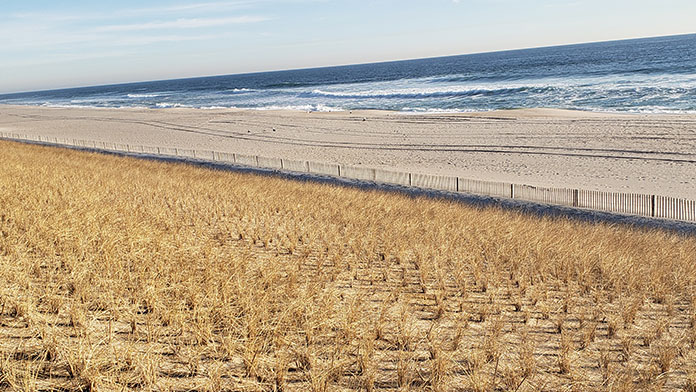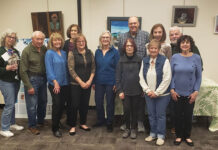
SEASIDE PARK – Borough officials are looking for support from the public, especially borough residents and property owners, to assist with a major dune grass replenishment project.
During the borough’s re-organization meeting, newly sworn-in Mayor John Peterson introduced a resolution that would provide needed work to complete the Army Corps of Engineers dune grass project.
The resolution calls for planting native vegetation on the west side of the newly augmented dune to provide stability to the dune in the future. This resolution was required because the Army Corps of Engineers project is at risk of deteriorating over the next several years on the west side of the beach.
Peterson first served as mayor in the 1980s when the first dune grass plantings began on the beach level near to the east of the boardwalk.
That effort, over three decades ago, resulted in a 22-foot-high dune along the entire ocean shoreline of Seaside Park and protected the ocean side of the Borough during Superstorm Sandy from moving water damage. Those dunes were the result of the planted beach grass being covered with blowing sand. The grass had to grow higher to survive as the sand covered and each subsequent year the dunes got higher and the grass roots formed a matrix under the sand to hold it in place, officials said.
The reason for this is that the American beach grass planted on the dune needs to be continually covered with blowing sand in order to remain healthy. That does occur on the east side of the dune but not on the west side of the dune, according to borough officials.
The American Beach Grass on the west side of the dune will die out over three to six years as a result.

Officials said that in order to anchor the sand on the west side of the dune, appropriate vegetation needs to be planted. This problem only exists on the south end of the borough from 10th Avenue to 14th Avenue and on the north side of the borough north of M Street.
The rest of the west side of the dune is covered with vegetation (roses, bayberry, goldenrod, and other plants) from before Superstorm Sandy which has spread since the 2012 megastorm and is in good shape, officials said.
The north and south end of town had its dune washed away by Superstorm Sandy and the dune had to be rebuilt by the borough. It was later augmented by Army Corps of Engineers project and is therefore populated by dune grass only.
As the Army Corps of Engineer project included planting only dune grass and as they have no plans to conduct additional plantings of needed vegetation, the Borough of Seaside Park has stepped up and passed this resolution.
Seaside Park intends to purchase appropriate plants such as bayberry, Virginia roses, Montauk daisies and beach plum and the cost will be offset by donations. Plantings will be done by the Seaside Park Department of Public Works with the help of volunteers.
Resident Bob Hopkins is overseeing several aspects of the dune project. He noted that while years ago residents of the borough “planted various kinds of vegetation (rugosa roses, bayberry, goldenrod, beach plum, etc.) over the years which made the dune even more storm resistant, this new project is quite different in that the dune is there.”
Hopkins said the current dune in Seaside Park is “made up of the dune that survived Sandy which has been augmented by the Borough and then by the Army Corps project which extended the entire length of the barrier peninsula from Manasquan Inlet to the entrance to Island Beach State Park and either augmented existing dune like in Seaside Park and Berkeley Township or built new dunes as in Ortley Beach.”
An excerpt from the New Jersey Sea Grant Consortium Dune Manual states “American beach grass (Ammophila breviligulata) is currently the species that is most often utilized in dune plantings in New Jersey and elsewhere in the northeast. Unfortunately, this species has very specific growth requirements and tends to thrive best in actively accreting sands in the frontal dune. After a few years, when the sand has become stabilized, the Ammophila breviligulata usually dies, yielding to other species that provide long-term dune coverage.”
The manual states that “over the past 25-30 years or so, it has been observed that throughout its native range beach grass is susceptible to decline after three to six years, especially when established on dredged sand in Army Corps of Engineers beach replenishment projects.”
Hopkins stressed that “this project is to address the lack of plants on the west side of the Seaside Park dune in the north and south ends of the Borough which now has only Army Corps planted American beach grass which will die out over the next few years.”
“The new vegetation is needed to secure the dune sand in those areas that will be left barren if nothing is done,” Hopkins added.

Those willing to help out with plantings in the spring (dates to be determined), should e-mail Hopkins at swimsmart@yahoo.com or call him at 973-903-3198.
Hopkins will be coordinating the volunteer list and will let volunteers know about upcoming planting dates. Those willing to make a donation to offset the cost of the plants are advised to write a check to the “Seaside Park Beautification Committee” with a note on it that the donation is for the “Seaside Park Dune Planting Project”. The check should be mailed to Seaside Park Beautification Committee, PO Box 84, Seaside Park, NJ 08752.






